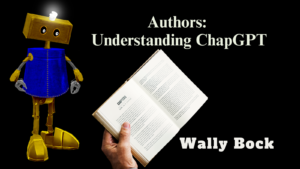ChatGPT is the talk of the town and the internet. It’s going to change the way many of us write. But, frankly, there’s more hype and hooey than helpful information about chat GPT and how writers can or should use it.
To use ChatGPT sensibly and effectively, you should start by understanding the program. That will make your expectations more reasonable and help you discover ways ChatGPT can help you write better.
What ChatGPT is designed to do
Let’s start with what ChatGPT is designed to do. It’s designed to carry on a human-like chat with a natural person. I say “human-like” because there are many things humans can do that ChatGPT can’t do.
The big thing ChatGPT is missing is emotion. Emotion is an important part of writing. It’s where the truth lives. ChatGPT can’t sort out the emotionally powerful from the emotionally insignificant.
What ChatGPT is not designed to do
ChatGPT is marvelous, but there are several things it’s not designed to do.
ChatGPT was trained using text databases, including text from books, web texts, Wikipedia, articles, and other pieces of writing on the internet. That’s a lot of data, but ChatGPT cannot use it to reason or judge. It will only share what it’s learned. It cannot tell you what’s correct or best. That’s up to you.
ChatGPT is a guessing machine.
ChatGPT was trained using a massive amount of data. One estimate is 570GB of text, including 300 billion words. It works on probability, guessing what word will come next in a sentence. Sometimes, it guesses wrong. When it does, ChatGPT may not make sense. OpenAI, the company that developed ChatGPT, puts it this way.
“ChatGPT sometimes writes plausible-sounding but incorrect or nonsensical answers.”
Be warned. Sometimes, this will be obvious. Other times, the answers may look perfectly fine despite being incorrect.
Things ChatGPT could do to you.
If you’re using ChatGPT to write all or part of your work, you’re taking chances with your work’s quality and reputation.
ChatGPT may produce material that quotes verbatim from someone else’s work. That’s plagiarism. You may not be able to spot it, but someone else may. And you’re responsible.
Ditto for bias. Bias is often embedded in our language. It shows up in what we call people and actions. ChatGPT can’t rid itself of bias. It can’t judge. You must.
ChatGPT can give you bad “facts.” It has no way to separate facts from opinion. It doesn’t fact-check. All of that is up to you.
Takeaways
ChatGPT is designed to carry on a human-like chat with a natural person.
ChatGPT cannot reason or judge.
ChatGPT cannot tell you what’s correct or best.
ChatGPT is a guessing machine. Sometimes, it guesses wrong.
“ChatGPT sometimes writes plausible-sounding but incorrect or nonsensical answers.”
ChatGPT may produce material that quotes verbatim from someone else’s work.
ChatGPT has no way to separate facts from opinion.
